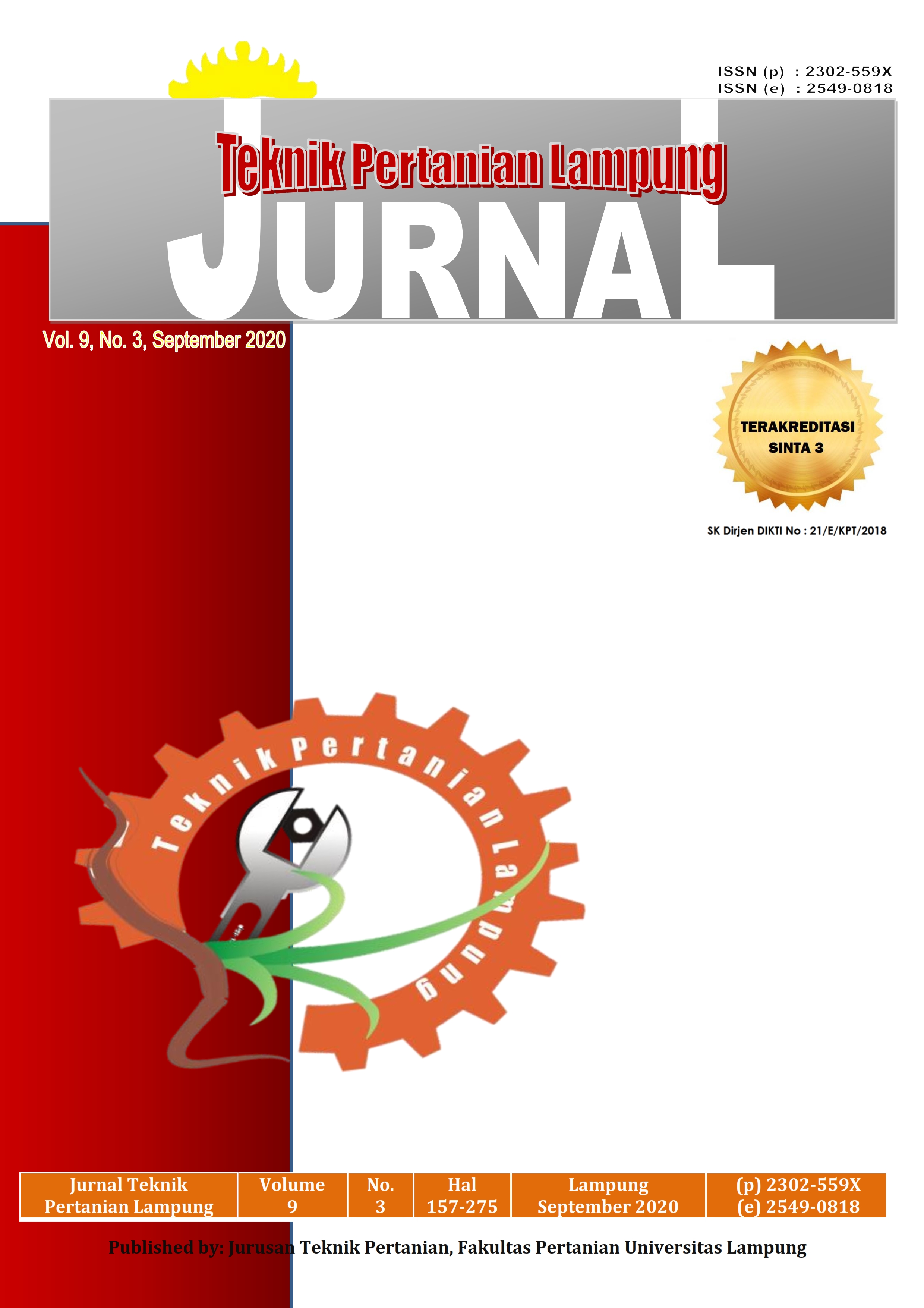SISTEM FERTIGASI RAIN PIPE OTOMATIS PADA MAIN NURSERY KELAPA SAWIT (Elaeis guineensis Jacq) BERBASIS MIKROKONTROLER ARDUINO UNO
DOI:
https://doi.org/10.23960/jtep-l.v9i3.184-190Abstract
This research conducted to designed, implemented, and tested an automatic rain pipe fertigation system using temperature and soil moisture sensors. The system applied to three irrigation treatments, namely manual fertilization, semi-manual fertilization, and automatic fertigation. The automatic fertigation actuator setting point is at temperature of 31 ° C and humidity of 60% to turn on the water pump and nutrient pump then the water pump will shut down when the temperature value of 25 °C and humidity of 80%. The results showed a significant difference in the use of irrigation water based on variance test results with an error value of 5%. The use of water from automatic fertigation is 12.770 ml or 65.9% more efficient than manual irrigation with the same growth in plant height. The height of oil palm plants in the main nursery with automatic fertigation is higher on days 7 to 12. Automatic fertilization requires a fertilizer of 1.8 tons per ha, less than manual fertilization which reaches 3 tons per ha.
Keywords: fertigation, microcontroller, oil palm, sensors, soil moisture
References
Agung Nugroho Adi (2010) Mekatronika. Yogyakarta: Graha Ilmu : Yogyakarta.
Candra, H. et al. (2015) ‘Design and Test Performance System Automatic Control on Drip Irrigation Using Microcontroller Arduino Mega’, Rancang Bangun Dan Uji Kinerja Sistem Kontrol Otomatis Pada Irigasi Tetes Menggunakan Mikrokontroller Arduino Mega Design, 4(4), pp. 235–244.
Das, S. et al. (2017) ‘Design and Development of Arduino based Automatic Soil Moisture Monitoring System for Optimum use of Water in Agricultural Fields’, International Journal of Engineering Research and Science, 3(5), pp. 15–19. doi: 10.25125/engineering-journal-ijoer-may-2017-6.
Husdi, H. (2018) ‘Monitoring Kelembaban Tanah Pertanian Menggunakan Soil Moisture Sensor Fc-28 Dan Arduino Uno’, ILKOM Jurnal Ilmiah, 10(2), pp. 237–243. doi: 10.33096/ilkom.v10i2.315.237-243.
Iyung Pahan (2011) Panduan Lengkap Kelapa Sawit: Manajemen Agribisnis dari Hulu hingga Hilir. Jakarta: Penebar Swadaya : Jakarta. Available at: https://books.google.co.id/books?id=XSptqDdEIc0C&printsec=frontcover&hl=id#v=onepage&q&f=false.
Mehla, M. K. et al. (2020) Farm Irrigations Systems Design Manual.
Netafim (2015) ‘Drip irrigation handbook: understanding the basics’, pp. 1–96. Available at: https://www.netafim.com/499749/globalassets/products/drippers-and-dripperlines/drip-irrigation-system-handbook.pdf.
Salih, J. E. M., Adom, A. H. and Shaakaf, A. Y. (2012) ‘Solar Powered Automated Fertigation Control System for Cucumis Melo L . Cultivation in Green House Solar Powered Automated Fertigation Control System for Cucumis Melo L . Cultivation in Green House’, 4(November 2015), pp. 79–87. doi: 10.1016/j.apcbee.2012.11.014.
Taufiq Caesar Hidayat, IY Harahap, Y Pangaribuan, S Rahutomo, WA Harsanto, W. F. (2013) Air dan Kelapa Sawit. Medan: Pusat Penelitian Kelapa Sawit. Medan.
Yasin, H. M., Zeebaree, S. R. M. and Zebari, I. M. I. (2019) ‘Arduino Based Automatic Irrigation System: Monitoring and SMS Controlling’, 4th Scientific International Conference Najaf, SICN 2019, 3(1), pp. 109–114. doi: 10.1109/SICN47020.2019.9019370.
Downloads
Published
Issue
Section
License
- Authors who publish with this journal agree to the following terms:
- Authors retain copyright and grant the journal right of first publication with the work simultaneously licensed under a Creative Commons Attribution-ShareAlike 4.0 International Lice that allows others to share the work with an acknowledgement of the work's authorship and initial publication in this journal.
- Authors are able to enter into separate, additional contractual arrangements for the non-exclusive distribution of the journal's published version of the work (e.g., post it to an institutional repository or publish it in a book), with an acknowledgement of its initial publication in this journal.
- Authors are permitted and encouraged to post their work online (e.g., in institutional repositories or on their website) prior to and during the submission process, as it can lead to productive exchanges, as well as earlier and greater citation of published work (See The Effect of Open Access).
Jurnal Teknik Pertanian Lampung

JTEPL is licensed under a Creative Commons Attribution-ShareAlike 4.0 International License.

